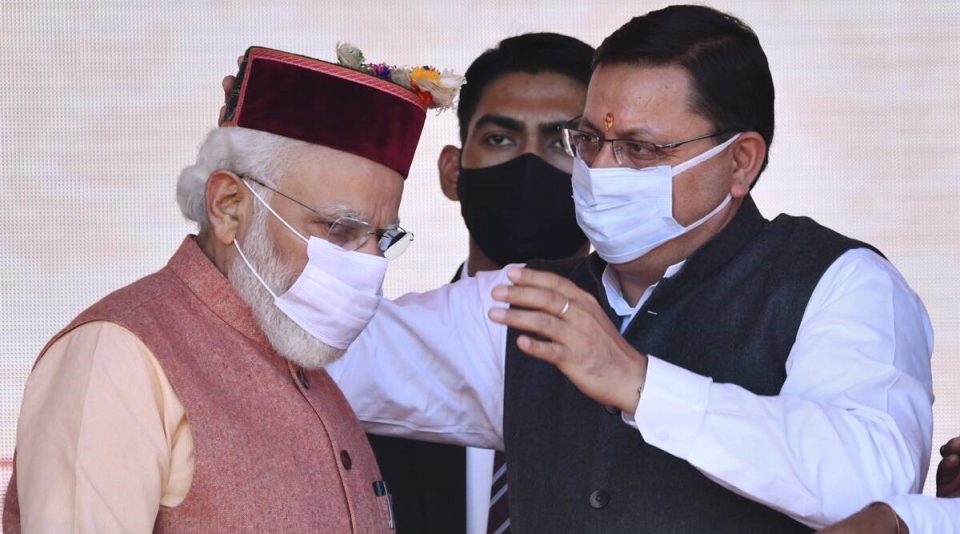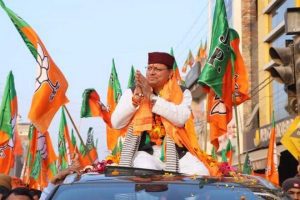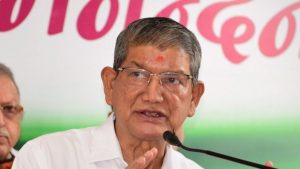
BJP faces an uphill task to retain bastions in Garhwal

As Uttarakhand goes to polls tomorrow (February 14), the ruling BJP will, predictably, be keeping a close eye on voting trends in the Garhwal region that accounts for 41 of the hill state’s 70 assembly seats. In the 2017 assembly polls, the BJP had won 57 seats in the state and 34 of these had come from the Garhwal region.
Five years later, heavy anti-incumbency in wake of rising prices, joblessness, growing distress migration and the taint of not allowing its chief ministers to complete a full tenure have collectively made the saffron party’s task of retaining power in Uttarakhand more daunting. To add to this mix is the electoral cliché of Uttarakhand not giving a second consecutive tenure to any incumbent government – a trend seen since the first assembly polls held in the hill state in 2002.
BJP insiders admit a strong performance in Garhwal is key to the party’s return to power in the state and that the likelihood of a 2017-like sweep in the region is “highly improbable”. In Uttarakhand, regional fault lines – the competing claims for socio-political, electoral, cultural and economic supremacy between the Garhwal and Kumaon hills – have always been starker than the communal divide seen in Uttar Pradesh, from which the state hill state was carved out in 2000.
The BJP, which during the first NDA government of Atal Bihari Vajpayee created Uttarakhand, has traditionally favoured its lawmakers from the Garhwal region for leading the state when in power. Between 2000 and the present, Uttarakhand has had seven CMs from the BJP (none that have completed a full five-year term).
Five of them – Nityanand Swami (the state’s first CM), BC Khanduri, Ramesh Pokhriyal ‘Nishank’, Trivendra Singh Rawat and Tirath Singh Rawat – have been from Garhwal while Bhagat Singh Koshyari and incumbent CM Pushkar Singh Dhami hail from Kumaon. In the present government, six of the BJP’s eleven ministers – Satpal Maharaj, Subodh Uniyal, Ganesh Joshi, Dhan Singh Rawat, Yatishwaranand, and Harak Singh Rawat (now with the Congress) – were from Garhwal.
For a party that unapologetically flaunts its rabid Hindutva politics to exploit religious sentiments of Hindus for electoral gains, the Garhwal region also offers a cultural landscape for communal polarisation, as has been on ample display in the BJP’s poll campaign of the past fortnight.
Also read: Jittered by anti-incumbency, BJP plays Hindu-Muslim card to retain ‘Devbhoomi’
The char dhams, which give Uttarakhand its Devbhoomi (land of the Gods) title, fall in the Garhwal region as does Haridwar, the site of the Kumbh Mela. “The BJP’s Hindutva plank finds a strong resonance in this region,” Jai Singh Rawat, Dehradun-based independent journalist and co-founder of the uttarakhandhimalaya.in portal told The Federal, pointing out the unprecedented communal polarisation the BJP has been viciously working up in Uttarakhand this poll season with promises of implementing a Uniform Civil Code, driving out Rohingya Muslims, enacting a stern law against love jihad and by accusing the Congress of appeasing Muslims with plans of setting up a Muslim University in the hill state (a claim denied repeatedly by the Congress) if voted to power.
Veteran journalist Umakant Lakhera, a native of Rishikesh that falls in the Garhwal hills, told The Federal the BJP faces a tough electoral contest this season because of the “extremely poor performance of its state government – the only one since 2000 to enjoy an absolute majority – and a large number of its MLAs in the Garhwal region are not only facing challenges of anti-incumbency against the party but also against themselves because many of them have not been seen in their constituencies in the past five years; in several segments there are also BJP rebels who are in the fray after being denied a ticket”.
Of the 41 seats in Garhwal, as many as 21 fall in the terai (the plains/foothills) districts of Haridwar and Dehradun. In 2017, the saffron party had bagged eight of the 11 assembly segments that fall in Haridwar, including Haridwar Rural from where the Congress had fielded its then sitting CM and current face of the poll campaign – Harish Rawat.
This time round, despite the appallingly communal polarisation caused by the Haridwar Dharam Sansad and other anti-Muslim statements by BJP leaders, the BJP is engaged in an uphill electoral battle with the Congress.
There are substantial pockets of Muslims in Haridwar – concentrated mainly in the Manglaur, Piran Kaliyar, Khanpur and Laksar constituencies – as well as concentration of Jats, Dalits, Gujjars and backward castes. With western UP districts like Muzzafarnagar, the epicentre of last year’s farmer protests, a short drive away and sugarcane farming also being a major agricultural activity in Haridwar, the BJP is also facing the ire of the district’s peasant community.
The maximum impact of the deadly COVID second wave in the state was also felt in Haridwar, which was hosting the Kumbh Mela at the time, and subsequent allegations of massive bungling in the vaccination drive are all relatively fresh in public memory.
Also read: BJP believes Modi factor will work again in Uttarakhand Assembly polls
“I lost two members of my family during COVID because they could not get proper treatment… sarkaari tantra kitna kroor aur nirdayi ho sakta hai woh humne Covid ke waqt pratyaksh dekha hai (we have seen for ourselves during the COVID wave how cruel and apathetic the government can be)… we will vote for anyone but the BJP,” Ashish Kumar, a resident of Khanpur told The Federal.
However, the BJP is hoping that a split in the Opposition’s vote between the Congress, Mayawati’s Bahujan Samaj Party (BSP), Arvind Kejriwal’s Aam Aadmi Party (AAP) and also Asaduddin Owaisi’s AIMIM, which has fielded candidates in the Muslim-dominated seats of Haridwar and other parts of Uttarakhand will help the party’s candidates pull through.

A BJP office bearer from Haridwar district told The Federal, “BSP has a strong presence in Haridwar and had finished second on two seats (Manglaur and Khanpur) in 2017. The AAP will have no major impact but whatever votes it will get in Haridwar are the anti-BJP votes while the AIMIM candidates will also hurt the Congress… With the exception of Haridwar, Haridwar Rural, Ranipur and Roorkee, most other assembly segments in Haridwar districts always see a very close contest; if the anti-BJP vote is split three ways, we will naturally be at an advantage because even a loss of 1500-2000 votes for the Congress candidate can swing the result in our favour.” He however conceded that the party’s candidates were “definitely facing a tougher challenge than 2017.
The Congress believes it has a fair chance of retaining the Manglaur, Piran Kaliyar and Bhagwanpur seats that it had won in 2017 and could also wrest the Roorkee, Khanpur and Jwalapur seats from the BJP. However, the key contest in this district is for Haridwar Rural between incumbent BJP MLA and minister Swami Yatishwaranand and Anupama Rawat, daughter of former CM Harish Rawat.

In 2017, Harish Rawat, then the sitting CM, had decided to contest the polls from Kichha and Haridwar Rural seats but had lost both. Anupama has been working in the constituency ever since with the hope of avenging her father’s defeat but Congress sources say she may face the same fate as her father given the substantial split of anti-BJP votes between the Congress and the BSP that is being anticipated in Haridwar Rural.
In Dehradun district that accounts for 10 assembly seats and has been a BJP bastion for decades, the Congress is hoping for a turnaround this election. In the 2017 polls, with the exception of the Chakrata assembly seat, the BJP had won all constituencies in Dehradun. Five years on, the saffron party is finding it difficult to retain the Dehradun Cantonment, Mussoorie, Vikasnagar and Sahaspur seats, while both Congress and BJP sources maintain that the saffron party will score an easy victory in the Rishikesh and Doiwala assembly segments.
If constituencies in the plains are witnessing a close contest, with the BJP banking its hopes of victory not on its performance but on the split of Opposition votes, the story is no different in the hills.
“Constituencies in the hills are witnessing a very keen contest. All promises of development that the BJP had made in 2017 have fallen flat in the past five years. Most BJP ministers in Garhwal are staring at defeat because of extreme public anger. The BJP is seeking votes in the name of the Char Dham corridor project but there is resistance from locals due to the environmental damage that the project is expected to cause in the hills. High prices of LPG cylinder have also turned the women voters, who had voted for the BJP in huge numbers, away from the party and the Congress’s promise of capping cylinder price at ₹500 has found resonance in the hills. The BJP has also not been able to deliver on its promise of stopping migration of youth from the hills to other states in search of job while the Congress is talking of a clear roadmap for employment generation,” independent journalist Avikal Thapliyal told The Federal.
In the landslide-prone Chamoli and Uttarkashi districts, which have also faced the brunt of severe economic distress, migration and poor infrastructure development, the anger against the BJP is palpable.
Of the six assembly segments – Purola, Yamunotri, Gangotri, Badrinath, Karnprayag and Tharali – in these two districts, the BJP had bagged five in 2017 while the Congress could manage to win only the Purola constituency.
“Despite the massive victory we gave to the BJP, the government did absolutely nothing for us in the last five years. The roads are non-existent, economic activity has crashed since COVID, there are still no proper hospitals and we have to drive 8 to 10 hours to get to Dehradun for any medical emergency… the Char Dham corridor, once completed, will also rob small hotels and tourism-related businesses in this area because tourists will no longer need to make pit-stops en route; we have no problem with the corridor but how will the government compensate us for the losses we will face due to the project… also the road expansion needed for the corridor will require cutting through the mountains and disturb the already fragile ecology of this region,” Amit Singh Bisht, a resident of Karnprayag told The Federal.
The BJP is hoping that it’s final lap of campaigning by Prime Minister Narendra Modi, Union home minister Amit Shah, UP chief minister Yogi Adityanath and other stalwarts will help the party contain much of the damage it was likely to face at the hustings.
Modi, Shah and Yogi, who is a Garhwal native, still enjoy enormous popularity in the region. During his campaign, Yogi spoke at length of his association with Garhwal during his childhood and youth – he was called Ajay Singh Bisht then – before he moved to Gorakhpur and joined the Nath Sampradaya that he now heads as Mahant. In stark contrast, the Congress that had shown a strong campaign in the region over the past month, mostly led by its local leaders and candidates, lagged behind with Rahul Gandhi and Priyanka Gandhi only making a fleeting appearance for the party.


